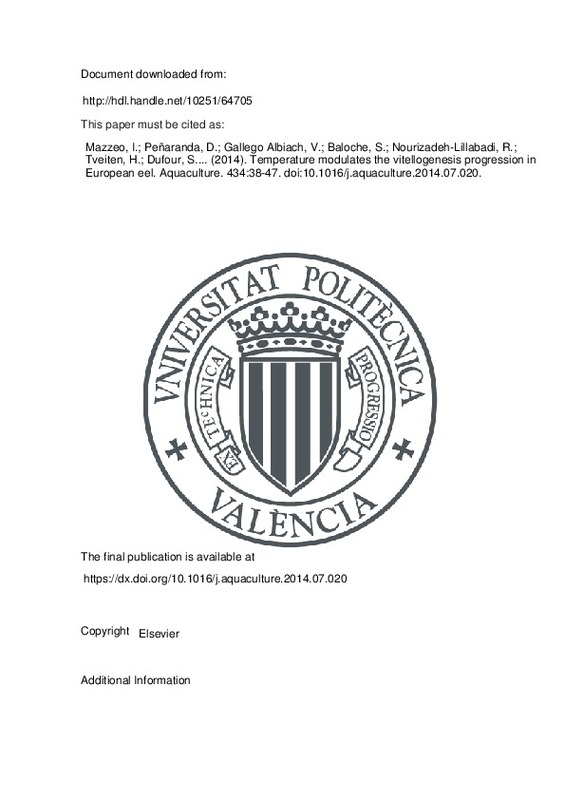JavaScript is disabled for your browser. Some features of this site may not work without it.
Buscar en RiuNet
Listar
Mi cuenta
Estadísticas
Ayuda RiuNet
Admin. UPV
Temperature modulates the vitellogenesis progression in European eel
Mostrar el registro sencillo del ítem
Ficheros en el ítem
| dc.contributor.author | Mazzeo, Ilaria
|
es_ES |
| dc.contributor.author | Peñaranda, D.S.
|
es_ES |
| dc.contributor.author | Gallego Albiach, Victor
|
es_ES |
| dc.contributor.author | Baloche, Sylvie
|
es_ES |
| dc.contributor.author | Nourizadeh-Lillabadi, Rasoul
|
es_ES |
| dc.contributor.author | Tveiten, H.
|
es_ES |
| dc.contributor.author | Dufour, Sylvie
|
es_ES |
| dc.contributor.author | Asturiano Nemesio, Juan Francisco
|
es_ES |
| dc.contributor.author | Weltzien, Finn-Arne
|
es_ES |
| dc.contributor.author | Pérez Igualada, Luz María
|
es_ES |
| dc.date.accessioned | 2016-05-25T12:57:38Z | |
| dc.date.available | 2016-05-25T12:57:38Z | |
| dc.date.issued | 2014 | |
| dc.identifier.issn | 0044-8486 | |
| dc.identifier.uri | http://hdl.handle.net/10251/64705 | |
| dc.description.abstract | [EN] Wild female European eels were matured with CPE (carp pituitary extract) under three thermal regimes, two of which were variable (T10–15 and T15–18, moving from 10 to 15 °C and from 15 to 18 °C, respectively) and one constant, at 18 °C (T18). Before and during hormonal treatment, the eels were sampled and biometric measurements were taken. Immunoassays of sex steroids and vitellogenin were performed, as well as qPCR analyses of gene expression (ovarian cyp19a1) and ovarian histology. Prior to the hormonal treatment, the silver eels which had been maintained at 18 °C showed lower 11-KT and E2 plasma levels compared to those maintained at 10 °C. In addition, in the early vitellogenic stage, the androgen and cyp19a1 levels were lower at 18 °C than at 10 °C. Both these results and the positive correlations found between GSI and 11-KT (at the PV stage) and between oocyte diameter and cyp19a1 levels (in the EV stage) suggest that early ovarian development is facilitated at low temperatures. Vitellogenesis was induced by CPE in all the thermal groups, but progression to the mid-vitellogenic stage was only observed after an accumulation of 900–1200 °D, at 15 or 18 °C, and progression to the late vitellogenic stage was only observed after an accumulation higher than 1300 °D, at 18 °C. Although temperature increased the rate of CPE-induced ovarian development, our results clearly indicate that this increase is not linear, but exponential, with acceleration in the increase of GSI at 18 °C from the mid-vitellogenic stage, or after an accumulation of 1300 °D. For the first time, a down-regulation of ovarian cyp19a1 caused by high temperatures in CPE-treated eels was observed. These results demonstrate that temperature can modulate eel ovarian development both before and after exogenous hormonal stimulations, and this knowledge could be used to manipulate the timing of vitellogenesis progression under laboratory conditions | es_ES |
| dc.description.sponsorship | This study was funded by the European Community's 7th Framework Programme under the Theme 2 "Food, Agriculture and Fisheries, and Biotechnology", grant agreement no.245257 (PRO-EEL). Ilaria Mazzeo and Victor Gallego had predoctoral grants from Generalitat Valenciana and Spanish Ministry of Science and Innovation (MICINN), respectively. David S. Penaranda has a postdoc grant from UPV (CEI-01-10), mobility grants from UPV (PAID-00-11) and the Research Council of Norway (EJ/hsm IS-SIP, 2009) and also has been supported by a contract co-financed by MICINN and UPV (PTA2011-4948-I). F.-A. Weltzien received funding from the Norwegian University of Life Sciences. | en_EN |
| dc.language | Inglés | es_ES |
| dc.publisher | Elsevier | es_ES |
| dc.relation.ispartof | Aquaculture | es_ES |
| dc.rights | Reserva de todos los derechos | es_ES |
| dc.subject | Anguilla anguilla | es_ES |
| dc.subject | Thermal regime | es_ES |
| dc.subject | Sex maturation | es_ES |
| dc.subject | Sex steroids | es_ES |
| dc.subject | cyp19a1 | es_ES |
| dc.subject.classification | BIOLOGIA ANIMAL | es_ES |
| dc.subject.classification | PRODUCCION ANIMAL | es_ES |
| dc.title | Temperature modulates the vitellogenesis progression in European eel | es_ES |
| dc.type | Artículo | es_ES |
| dc.identifier.doi | 10.1016/j.aquaculture.2014.07.020 | |
| dc.relation.projectID | info:eu-repo/grantAgreement/EC/FP7/245257/EU/Reproduction of European Eel: Towards a Self-sustained Aquaculture/ | es_ES |
| dc.relation.projectID | info:eu-repo/grantAgreement/UPV//CE-01-10/ | es_ES |
| dc.relation.projectID | info:eu-repo/grantAgreement/UPV//PAID-00-11/ | es_ES |
| dc.relation.projectID | info:eu-repo/grantAgreement/MICINN//PTA2011-4948-I/ES/PTA2011-4948-I/ | es_ES |
| dc.relation.projectID | info:eu-repo/grantAgreement/RCN//EJ%2Fhsm IS-SIP/ | es_ES |
| dc.rights.accessRights | Abierto | es_ES |
| dc.contributor.affiliation | Universitat Politècnica de València. Departamento de Ciencia Animal - Departament de Ciència Animal | es_ES |
| dc.contributor.affiliation | Universitat Politècnica de València. Instituto de Ciencia y Tecnología Animal - Institut de Ciència i Tecnologia Animal | es_ES |
| dc.description.bibliographicCitation | Mazzeo, I.; Peñaranda, D.; Gallego Albiach, V.; Baloche, S.; Nourizadeh-Lillabadi, R.; Tveiten, H.; Dufour, S.... (2014). Temperature modulates the vitellogenesis progression in European eel. Aquaculture. 434:38-47. https://doi.org/10.1016/j.aquaculture.2014.07.020 | es_ES |
| dc.description.accrualMethod | S | es_ES |
| dc.relation.publisherversion | https://dx.doi.org/10.1016/j.aquaculture.2014.07.020 | es_ES |
| dc.description.upvformatpinicio | 38 | es_ES |
| dc.description.upvformatpfin | 47 | es_ES |
| dc.type.version | info:eu-repo/semantics/publishedVersion | es_ES |
| dc.description.volume | 434 | es_ES |
| dc.relation.senia | 268997 | es_ES |
| dc.identifier.eissn | 1873-5622 | |
| dc.contributor.funder | European Commission | |
| dc.contributor.funder | Ministerio de Ciencia e Innovación | |
| dc.contributor.funder | Universitat Politècnica de València | |
| dc.contributor.funder | Research Council of Norway |







![[Cerrado]](/themes/UPV/images/candado.png)

